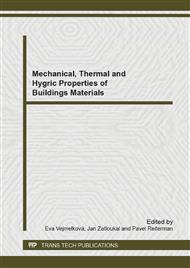[1]
R. Černý, M. Keppert, J. Kočí, V. Kočí, P. Konvalinka et al, Complex System of Methods for Directed Design and Assessment of Functional Properties of Building Materials and Its Applications. 1. ed. Praha: České vysoké učení technické v Praze, (2013).
Google Scholar
[2]
T. Benetková, Critical analysis of methods for study of pore structure of cement composites contatingn sexondary raw materials, [diploma thesis], České vysoké učení technické v Praze, (2010).
Google Scholar
[3]
C.A. Bovik, The essential guide to image processing, Academic Press, (2009).
Google Scholar
[4]
Image Processing Toolbox for MATLAB, The Mathworks Inc., 2014. [http: /www. mathworks. com/products/image/].
Google Scholar
[5]
NIS Elements Basic Research Imaging software, Nikon Instruments Europe B.V., 2014. [http: /www. nikoninstruments. com/en_CZ/Products/Software/NIS-Elements-Br-Microscope-Imaging-Software].
Google Scholar
[6]
Adobe Photoshop CS6, Adobe Systems Software Ireland Ltd., 2014. [http: /www. adobe. com/cz/products/cs6. html].
DOI: 10.18411/svfu-2017-105
Google Scholar
[7]
M. Jerman, M. Keppert, J. Výborný, R. Černý, Hygric, thermal and durability properties of autoclaved aerated concrete. In: Construction and Building Materials. 2013, vol. 41, no. 1, pp.352-359.
DOI: 10.1016/j.conbuildmat.2012.12.036
Google Scholar
[8]
M. Jerman, V. Kočí, J. Maděra, J. Výborný, R. Černý, Water and heat transport parameters of materials involved in AAC-based building envelopes In: 1st Central European Symposium on Building Physics. Lodz: Technical University of Lodz, 2010, pp.39-45.
DOI: 10.2495/ht100251
Google Scholar
[9]
E. Vejmelková, P. Konvalinka, R. Černý, Thermal properties of aramid-fiber reinforced cement composite. In: Concrete under Severe Conditions - Environment and Loading. Leiden: CRC Press/Balkema, 2010, pp.965-972.
DOI: 10.1201/b10552-122
Google Scholar
[10]
P. Rusinowski and B. Täljsten, Intermediate Crack Induced Debonding in Concrete Beams Strengthened with CFRP Plates — An Experimental Study, Advances in Structural Engineering. 12/6 (2009) 793-806.
DOI: 10.1260/136943309790327699
Google Scholar
[11]
Y. Liu, S. Teng, Ch-K. Soh, Three-Dimensional Damage Model for Concrete. I: Theory, Journal of engineering mechanics (2008) 72-81.
Google Scholar


